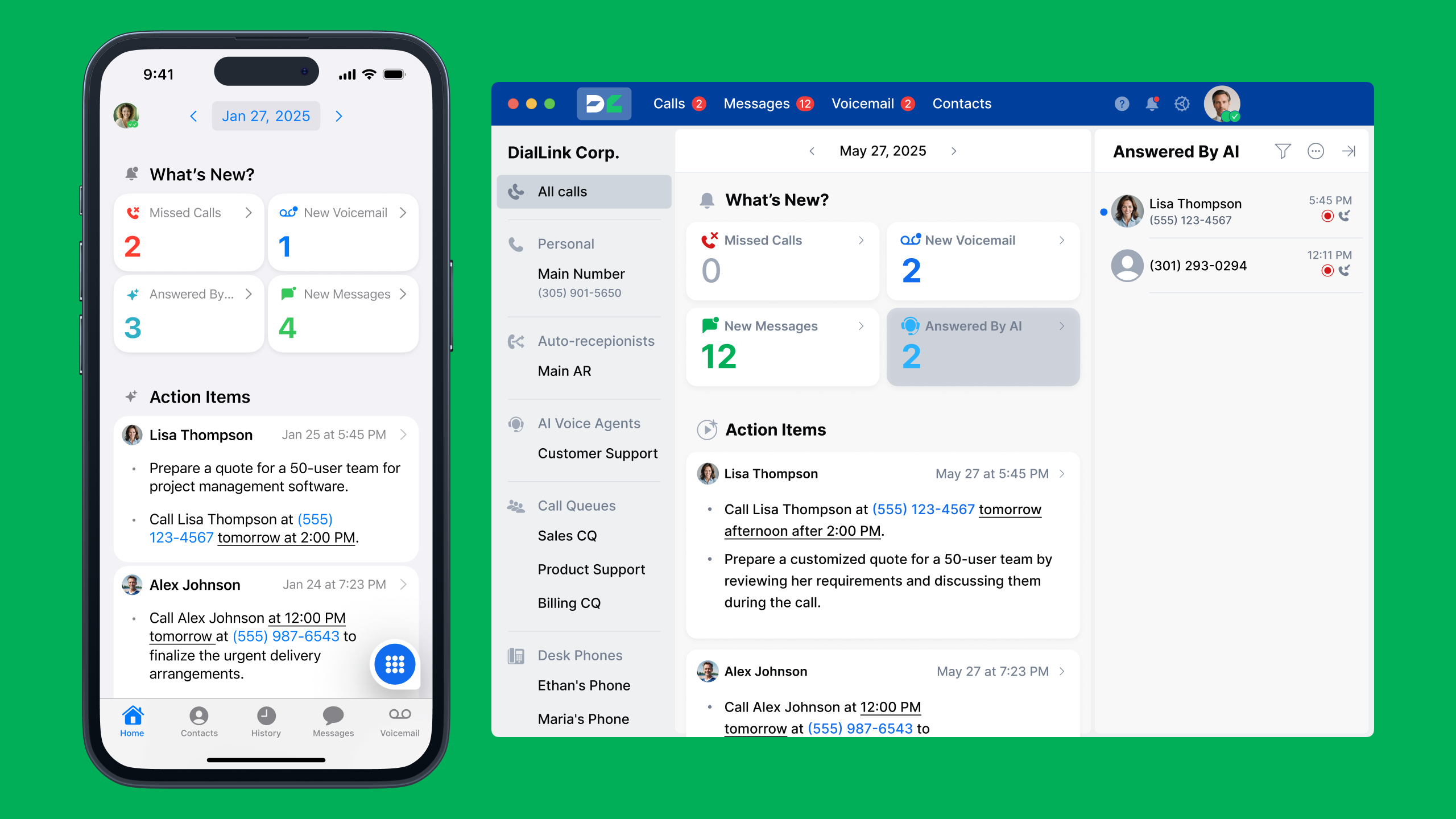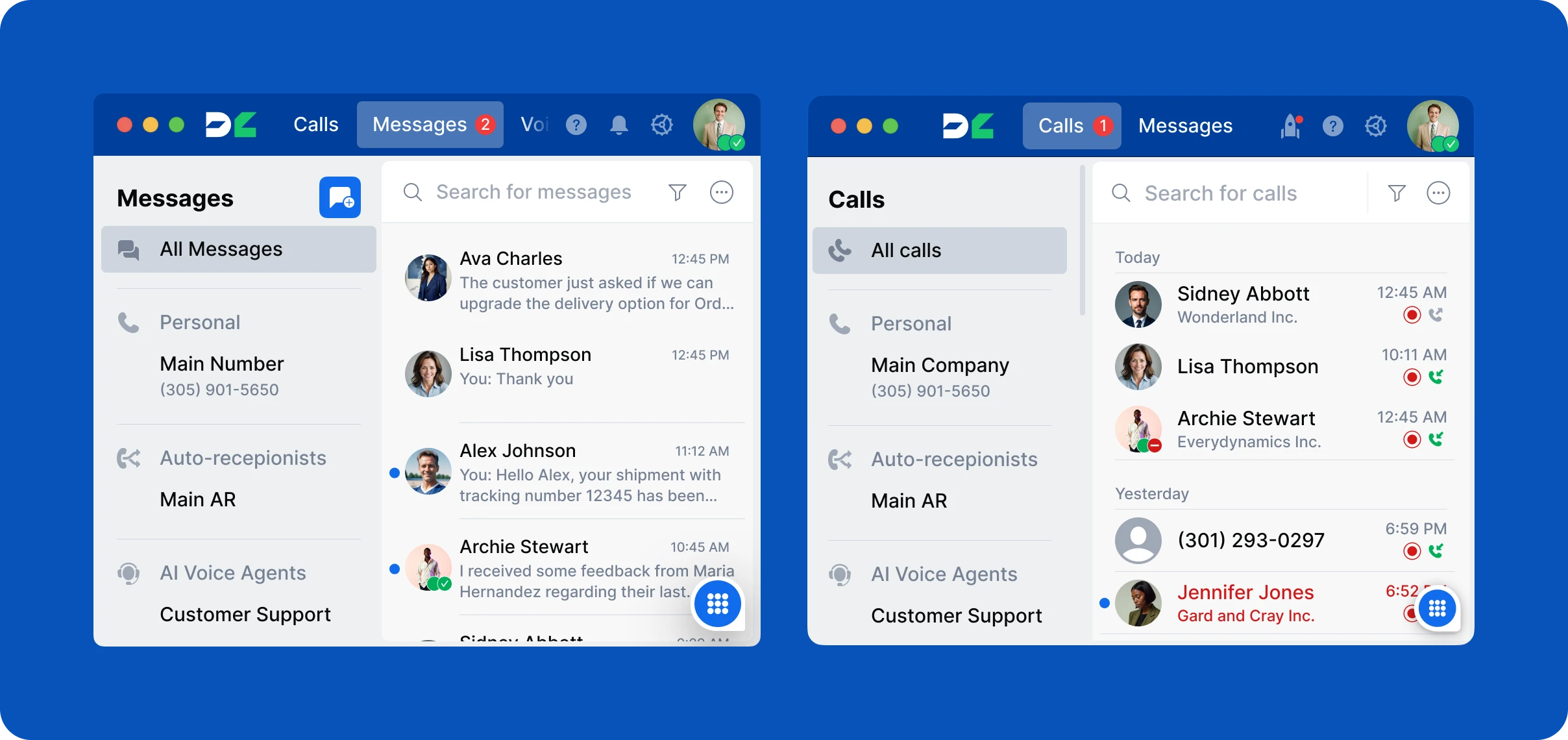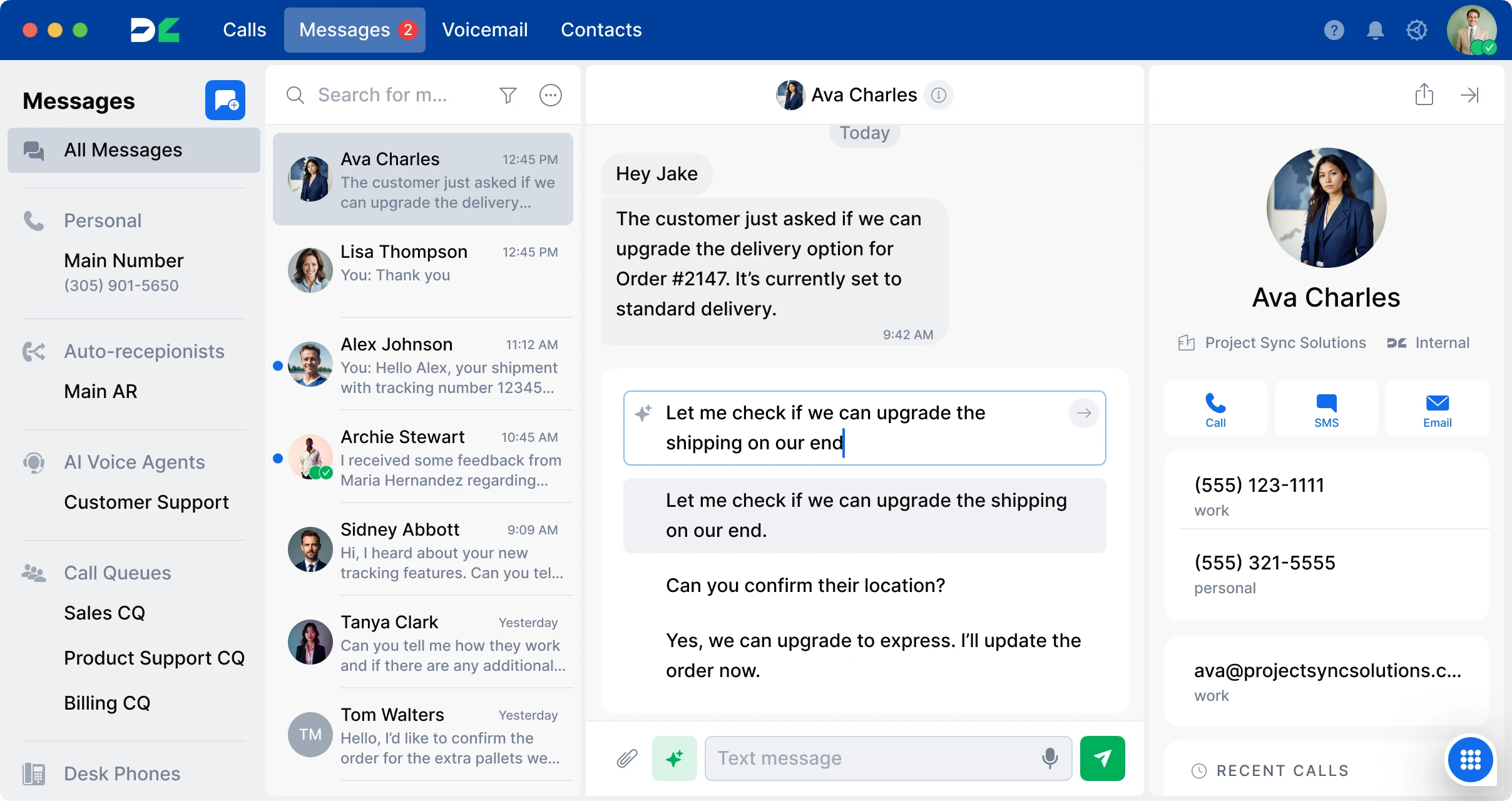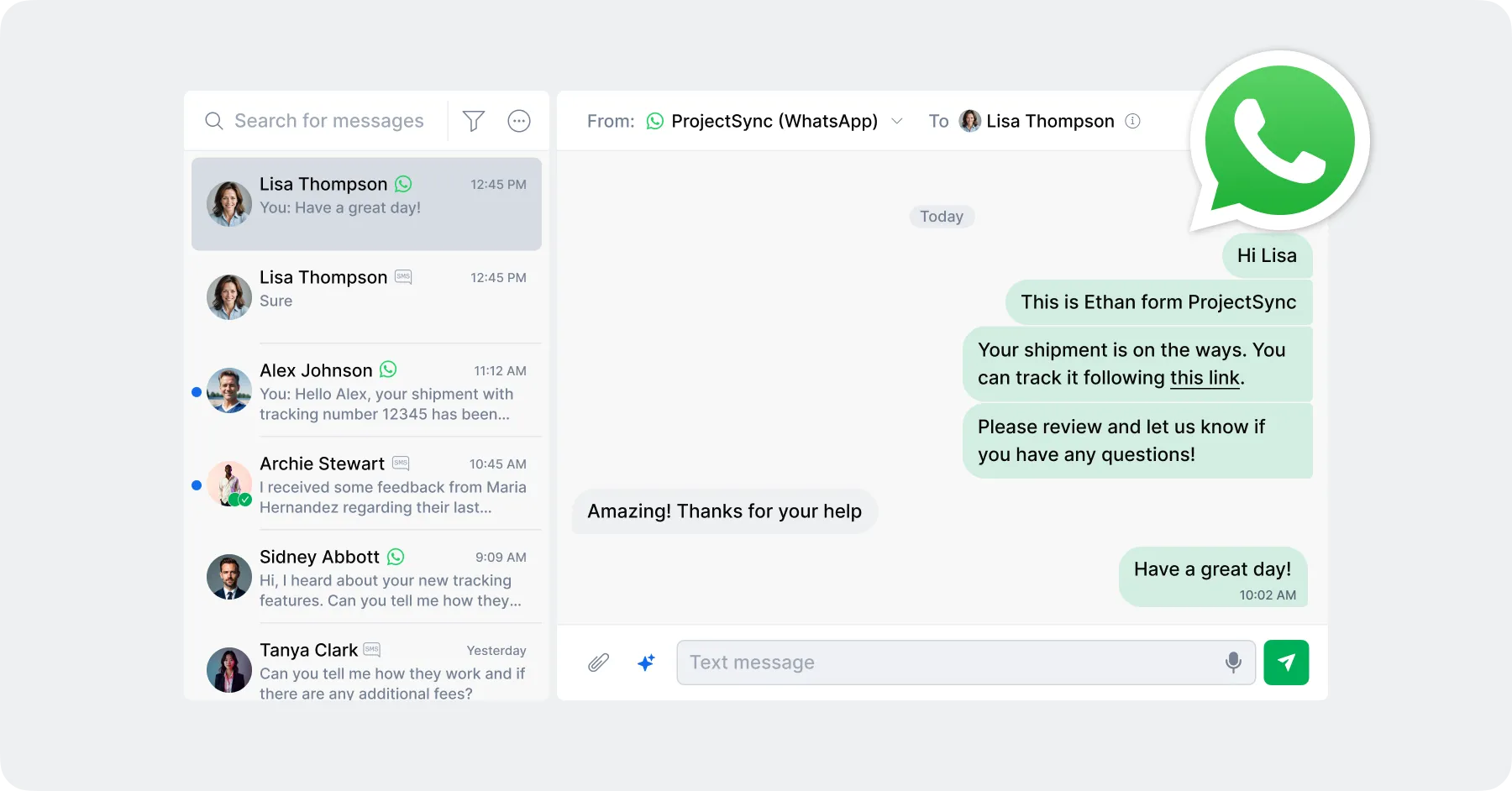Blog
Cloud Phone System
What Is a Virtual Phone Number and How to Get One for Your Business?

What Is a Virtual Phone Number and How to Get One for Your Business?
Learn what virtual phone numbers are, how they work, the types available, and how to get one for your business with DialLink.
Being reachable for your customers shouldn’t mean being tied to a desk phone or a single SIM card. A virtual phone number lets businesses communicate from anywhere, using just the internet, while keeping a professional presence.
In this guide, we’ll break down what virtual phone numbers are, how it works, the different types available, and the steps to get a virtual phone number for your business. We’ll also explore practical use cases, texting capabilities, and how to choose the right virtual phone number provider for your business.
What Is a Virtual Phone Number?
A virtual phone number, sometimes called an “online” or “digital” phone number, is a number that isn’t tied to a specific physical device or SIM card. Instead, it runs over the internet, using cloud-based systems to route calls to any device you choose, whether it’s your smartphone, computer softphone, or VoIP desk phone.
For you as a customer, it works just like a regular phone number. But behind the scenes, it gives your business a level of control, flexibility, and mobility that traditional phone lines simply can’t match.
How Do Virtual Phone Numbers Work?
A virtual business phone number is typically part of a virtual phone system, VoIP phone system, or a dedicated virtual phone number app. At the heart is VoIP (Voice over Internet Protocol) technology, which allows you to make and receive calls over the internet.
Think of VoIP like sending a letter online instead of by post. Your voice is broken into tiny “digital packets,” sent across the internet, and reassembled into sound on the other end, all in real time. Just like an email reaches the recipient without needing a physical envelope, your voice travels digitally to reach its destination.
When someone calls your virtual number, the call passes through your VoIP service provider’s servers and is directed to the destination you’ve chosen. This could be your smartphone, a computer running softphone software, a VoIP desk phone, or even multiple devices at once.
Types of Virtual Phone Numbers
Virtual phone numbers for businesses come in several types, each designed to meet different business needs. Here’s a look at the most common options:
- Local phone numbers: These numbers use an area code from a specific city or region, helping your business appear local and trustworthy. For example, a startup based in Austin could have a 512 number, even if the team works remotely from other states.
- Toll-free phone numbers: Numbers like 800, 888, or 877 let customers call you without any charge, making them ideal for nationwide customer support or marketing campaigns.
- International phone numbers: These numbers allow businesses to establish a presence in other countries. For instance, a U.S. company can have a UK or Australia virtual phone number that forwards directly to the main team, helping you expand globally.
- Vanity numbers: These are memorable numbers that spell out words or use easy-to-remember sequences (e.g., 1-800-FLOWERS). Vanity numbers are excellent for branding, marketing, and making your business easy to recall.
You may also hear the term “virtual office phone number.” This isn’t a separate type of virtual number; it simply refers to using a virtual phone number as part of a virtual office setup. Even without a physical office, a virtual office number gives your business a professional presence, complete with a business address and phone line, helping you appear established while keeping overhead low.
Alternatives of Virtual Phone Numbers for Small Businesses and Startups
While virtual phone numbers offer flexibility and professional features, small businesses and startups may also consider other options. Here’s a look at some common alternatives and their pros and cons:
Traditional Landline Numbers
Landlines have been the standard for business communication for decades. They are reliable and provide consistent call quality, but they come with limitations: they tie you to a physical location, are difficult to scale as your team grows.
Cell Phone Numbers
Using mobile phone numbers can provide flexibility, as employees can take calls from anywhere. However, they lack centralized control, making it difficult to manage multiple lines or track customer interactions. Mobile numbers also generally don’t support advanced business features, such as call routing, auto-attendants, or analytics, which are important for businesses. Unlike traditional landlines or personal cell phones, virtual phone numbers combine mobility with control. They allow small businesses and startups to present a professional image, manage calls across multiple devices, track communications, and integrate with other tools — all without the cost and limitations of physical phone lines.
Benefits of Virtual Phone Numbers for Small Businesses and Startups
Business virtual phone numbers offer a range of advantages that make them particularly valuable for small businesses and startups. Here are some of the key benefits:
1. Synced communication across multiple devices
Calls to virtual phone numbers can be routed to multiple devices simultaneously, including smartphones, laptops, desktop computers, or VoIP desk phones. This ensures your team never misses an important call, no matter where they are.
When your virtual phone number is integrated with a cloud-based phone system like DialLink, not only can calls be placed and received on all devices, but call history, contacts, voicemail, and settings are also automatically synchronized. Your team can access everything they need in a single platform from any device.

2. Affordable option for smaller businesses and startups
Virtual phone numbers are a cost-effective alternative to traditional phone lines. They give small businesses and startups access to professional features without the high overhead.
With a virtual system, your service provider handles management and maintenance, and you pay a predictable monthly fee, eliminating costs for installation or expensive hardware.
Virtual phone numbers also support remote work, allowing employees to use their preferred devices from anywhere. This flexibility can help businesses reduce office space, save on rent, and cut technology expenses, making virtual phone numbers a smart investment for growing companies.
3. Easy to manage and scale
As your business grows, virtual numbers can be added, removed, or reassigned instantly. This flexibility makes it simple to adapt to changing team sizes, departments, or business locations without the hassle of physical infrastructure.
4. Separate business and personal communications
With a virtual phone number, you can keep your business calls and messages separate from personal ones, helping maintain a professional image and better manage work-life balance. Customers only see your business number, even if you’re using your personal device to take calls.
5. Access to global markets
Virtual phone numbers allow businesses to establish a presence in different cities or countries without opening a physical office. You can have local, toll-free, or international numbers that forward calls to your team anywhere in the world, making it easier to expand your reach and build trust with clients globally.
How To Get a Virtual Phone Number?
Getting a virtual phone number for your business can be a quick and straightforward process if you know where to start. Follow this guide to set up your virtual phone number:
Step 1: Identify Your Needs
Start by clarifying how you plan to use the virtual phone number. Will it serve as your main business line, a customer support line, or for personal use?
- Personal use: Free virtual number providers may suffice, though they often come with limitations such as fewer features or restricted call volumes.
- Business use: Consider whether you need the number in a specific country or area code. Decide if you require additional features such as texting, multiple extensions, or toll-free capabilities. Clearly defining your needs will make it easier to choose the right provider and the appropriate type of virtual number.
Step 2: Choose a Virtual Phone Number Provider
Select a VoIP phone system provider that offers virtual phone numbers with the coverage, features, and integrations you require. Compare options for local, toll-free, or international virtual phone numbers. Ensure your provider supports security, compliance, and integration with your essential business tools.
Step 3: Sign Up with Your Chosen Provider
Create an account with the provider you selected, following their onboarding instructions to get started.
Step 4: Pick Your Number(s) and Area Code
Decide whether you want a new number, a toll-free number, an international number, or to port an existing business number. Create a virtual phone number that align with your target markets to make it easier for customers to reach you.
Choose Your Local Phone Number
Step 5: Set Up and Configure Call Features
Assign phone numbers to team members or departments, and configure essential settings such as call forwarding, voicemail, and custom greetings.
Step 6: Enable Omnichannel Communication
With the right provider, your virtual number can handle calls, SMS, RCS, WhatsApp, and other digital channels — all seamlessly from a single platform.

Step 7: Test Your Virtual Phone Number
Make test calls and send messages to confirm that everything works as expected. Ensure calls are routed correctly and all features are functioning.
Step 8: Publish Your Virtual Phone Number
Add your virtual number to your website, business cards, social media profiles, and any customer-facing materials to make it easy for clients to reach you.
Key Features You Should Get with Virtual Phone Number
While free virtual phone number apps provide only a basic phone number, a virtual phone system offers a range of features designed to help businesses communicate efficiently and professionally. Here are the key features to look for:
Shared Phone Numbers
A shared phone number allows multiple team members or departments to receive and answer calls from the same line. This makes it easier to manage teams in sales, support, or customer success, while ensuring no call goes unanswered. Shared numbers also provide transparency: everyone can see missed calls, voicemails, and messages in a centralized system.
Customizable Call Flows
Call flows give you complete control over how incoming calls to your virtual phone number are handled, allowing you to tailor every interaction to your business and customer needs. Common features include:
- Custom business hours – Decide when your virtual phone number is “open” or “closed” to calls. You can set different schedules for weekdays, weekends, or holidays, and route calls differently based on the time of day. For example, calls outside business hours can be directed to voicemail, an answering service, or even a colleague on call.
- Interactive voice response (IVR) menus – IVR menus guide callers to the right department or team member using a simple keypad or voice commands. For instance, pressing “1” could connect to sales, “2” to support, and “3” to billing. IVR reduces wait times, ensures calls reach the right team, and creates a professional impression for your business.
- Call queues – Place multiple callers in a queue during peak hours while keeping them informed with custom messages or music on hold. Call queues help manage high volumes efficiently and prevent lost calls during busy periods.
- Ring groups – With ring groups, multiple team members’ phones ring simultaneously or sequentially, ensuring that someone is always available to answer. This is especially useful for small teams where flexibility is key.

Call Forwarding
Call forwarding keeps your business reachable no matter where you or your team are. Incoming calls to your virtual phone number can be routed to mobile phones, desktop softphones, or other devices, ensuring that important calls are never missed.
You can customize forwarding rules based on time or availability. For example, if you’re on vacation, in a meeting, or outside of business hours, calls can automatically be redirected to another team member, a shared line, or voicemail. This flexibility ensures seamless communication for your customers while giving your team the freedom to work from anywhere.

Voicemail
Voicemail lets your business capture important messages when calls aren’t answered. Advanced systems like DialLink provide voicemail-to-text or voicemail-to-email features, so you can read messages instantly without listening to audio. This feature ensures you never miss critical information and allows for faster response times.
Business Messaging
Modern virtual phone systems go beyond voice calls by supporting multiple messaging channels, including SMS, RCS, and WhatsApp, all linked to your virtual phone number. This allows your business to communicate with customers on the platforms they prefer while maintaining a professional, unified presence.
You can send messages directly from your business number, schedule texts for later, or create automated replies to acknowledge inquiries and set expectations for response times.

AI Automations
AI-powered features take productivity to the next level. Advanced virtual phone systems like DialLink bundle a suite of intelligent tools to automate routine tasks and extract actionable insights from every call. Key AI features include:
- AI voice agents – Handle routine inbound or outbound calls 24/7 on your behalf, such as answering FAQs, qualifying leads, sending reminders, or collecting information, freeing up your team to focus on higher-value work.
- AI transcriptions – Calls are automatically transcribed in real time, creating accurate, searchable records of conversations for reference, compliance, or team collaboration.
- AI call intelligence – Automatically tag calls, generate summaries, extract key discussion points, and create actionable items. Advanced systems can even perform sentiment analysis to gauge customer satisfaction or detect potential issues.
For example, after a sales call, the system can categorize the call, log meeting notes, define follow-up tasks, and capture key insights. These automations save time, reduce human error, and ensure that critical information is always recorded, organized, and easily accessible to your team.

Limitations of Free Virtual Phone Numbers
While free virtual phone number apps may work for personal use, they are rarely suitable for businesses, even for small businesses and startups, because they come with significant limitations that can affect your credibility and performance.
- Limited functionality – Free virtual numbers typically offer only basic calling and sometimes texting. Essential business features such as call forwarding, voicemail, and call routing are either unavailable or come with additional fees.
- Security concerns – Free numbers are often recycled and may be flagged as spam, making it harder for your customers to reach you. Since you don’t truly own the number, you risk losing it without warning, which can disrupt business communication and confuse clients. Additionally, free numbers are often untrusted by two-factor authentication (2FA) systems, adding complications to secure business operations.
- Device limitations – Most free apps are mobile-only and do not support desktops or laptops. This restricts flexibility for remote teams and limits the ability to manage calls across multiple devices.
- Interruptions and ads – Free services may include intrusive advertisements, call limits, and lower call quality during peak hours. These interruptions can frustrate customers and reduce your professional image.
A professional virtual phone number provider like DialLink eliminates these challenges. It offers secure, dedicated phone numbers with advanced features, all accessible from any device without ads or restrictions. This ensures your business maintains a reliable, professional, and seamless communication experience.
Common Use Cases for Virtual Phone Numbers
Virtual phone numbers are highly versatile, making them suitable for businesses of all sizes: established enterprises, startups, small businesses, and freelancers. Here are some practical ways they can be used effectively:
Business Phone Line
A virtual phone number can serve as your main business line. Instead of installing a landline, you can obtain a number that forwards calls to your team wherever they are. As your business grows, adding additional numbers or extensions is simple. This number becomes the central point of contact on your website, business cards, and Google listings, providing a professional and consistent presence.
Contact Points for Multiple Departments or Team Members
Even small teams can appear highly organized. Virtual numbers allow you to assign dedicated lines for different departments or team members while keeping everything centralized under one system.
Global Customer Support
Virtual numbers make establishing an international presence easy. You can offer toll-free numbers for nationwide coverage, letting customers contact you without incurring charges. Alternatively, you can provide local numbers in multiple locations, routed to local teams or a central support center.
Privacy for Freelancers, Solopreneurs and Small Business Owners
Virtual numbers act as a privacy shield. Freelancers, solopreneurs, and small business owners can use them on contracts, online listings, or websites instead of personal numbers. They can be turned off after hours or discontinued if needed, protecting personal contact information. Combined with a virtual address, a virtual number creates a professional “business identity” separate from personal life.
Temporary Numbers for Marketing Campaigns
For short-term campaigns, you can assign unique virtual numbers to track marketing performance. Each number routes to the same team but allows you to measure which campaign generates the most calls. Temporary numbers can also be used for events or one-off campaigns and discontinued afterward, keeping communications organized and easily traceable.
Internal Communications and Team Calls
Virtual numbers aren’t limited to external communications. Teams can assign virtual extensions or direct numbers for internal use, enabling seamless call transfers and quick dialing between team members. Even fully remote teams can operate like a traditional corporate phone network, using softphone apps or desktop devices for cohesive internal communication.
Using Virtual Phone Numbers for SMS, Texting and Messaging
One major advantage of many virtual phone number services is that they support text messaging alongside voice calls. This enables a variety of practical business use cases:
Two-Way Business Texting
Customers increasingly prefer texting for quick questions or updates. A virtual number allows you to send and receive SMS through an app or web interface. For example, a customer might text, “Can I reschedule my appointment?” and your team can reply directly from the same business number. Text-enabled virtual numbers help unify communication and appeal to audiences who favor messaging.
Alerts and Updates via SMS
Businesses can use virtual numbers to send timely alerts and updates, such as service notifications, shipping confirmations, or appointment reminders. This keeps customers informed while maintaining a professional and consistent communication channel.
Sending Verification Codes (OTP)
Businesses can use virtual phone numbers to send one-time passwords (OTPs) or verification codes to their customers for account sign-ups, password resets, or two-factor authentication (2FA). This ensures secure and reliable communication while keeping your personal number private.
Marketing Campaigns via RCS
Virtual phone numbers enable businesses to send opt-in promotional messages and special offers directly to customers. For instance, restaurants, salons, and retail stores can share daily deals or limited-time promotions. Using the same virtual phone number for both calls and messages maintains brand consistency, and customers can easily respond or call back. For a richer, more interactive experience, RCS messaging allows businesses to include images and action buttons.

WhatsApp and Other Messaging Apps
Messaging apps have become essential channels for businesses to connect with customers for support, promotions, updates, and more. To maintain a consistent customer experience, use the same virtual phone number for WhatsApp and across other messaging platforms. This ensures all communications are centralized and recognizable, strengthening your brand presence.

Conclusion: Get a Virtual Phone Number for Your Small Business or Startup
Virtual phone numbers may seem like a small tool, but they pack a powerful punch for your business. They unlock numerous benefits, from cost savings and easy scalability to seamless omnichannel communication. Whether you need a number for business calls, text messaging, or to establish a local presence in another city, a virtual phone number can meet your needs.
When selecting a virtual phone number, it’s important to consider both your business needs and the provider you choose.
With DialLink, getting a virtual phone number is just the start. Our platform delivers a complete AI-powered phone service built specifically for SMBs and startups. It’s easy to set up, fully scalable, and packed with advanced features like smart call routing, call queues, IVRs, and AI-powered capabilities — all at affordable rates.
Get your virtual phone number with DialLink today!
Some providers offer free virtual phone numbers, but they often come with limitations, such as restricted calling, low call quality, and security issues. For a reliable business presence, it’s better to choose a paid virtual number, which ensures consistent call quality, scalability, and access to advanced call features.
Porting your current phone number depends on your virtual phone system provider, but the process is usually straightforward. With DialLink, you can follow a fully automated number porting process: simply submit your existing number and account details, then follow the provided instructions. Once approved, your number is moved to the virtual platform, allowing you to make and receive calls without changing your business contacts.
Virtual phone numbers are available in many countries worldwide. Most providers offer local, toll-free, and international numbers across North America, Europe, Asia, and beyond. You can get a virtual phone number for the United States (USA), United Kingdom (UK), Canada, Australia, or even specific locations like California, Florida, or Los Angeles. Availability varies by provider, so check the countries and regions where you want to establish a business presence.
Virtual numbers work on multiple devices. You can use them on your mobile phone, tablet, desktop, or laptop, as well as on VoIP desk phones. This makes it easy for your team to stay connected anywhere, whether in the office or remotely.
Yes. Virtual phone numbers support both inbound and outbound calls. Depending on your provider, you may also access features like call forwarding, smart routing, call queues, and AI-assisted calling to enhance business communication.
Many virtual phone providers offer toll-free numbers (like 800, 888, 877, etc.). Simply choose a toll-free option during the signup process. Toll-free numbers allow customers to call your business without charges, helping build trust and accessibility.
Virtual phone numbers generally cannot be used for emergency services in the same way as traditional landlines or mobile numbers. Some providers offer emergency dialing features, but it’s recommended to have a reliable backup method for contacting emergency services.
A virtual office number is a virtual office with phone number paired with additional services like a receptionist, call handling, and professional greetings. While a standard virtual number simply forwards calls, a virtual office number gives your business the appearance of a staffed office, enhancing professionalism and customer experience, especially for small businesses, startups, and remote teams.
Share this post

Arina Khoziainova
Content Writer at DialLink
Arina is a content writer with over 7 years of experience in the IT industry. At DialLink, she creates clear, insightful content that helps small business and startup owners simplify communication and drive growth using modern tools. With a strong focus on practical value, Arina transforms complex topics into accessible, actionable stories.
Keep Reading

What is an Outbound Call Center? Everything SMBs and Startups Need to Know
Learn what an outbound call center is, why it’s important for businesses, and how outbound call center services and software help them operate efficiently.
August 29, 2025
20 minutes

Virtual Local Phone Numbers: Overview and Benefits
Explore everything you need to know about virtual local phone numbers to help you choose the right one for your business.
December 13, 2025
7 minutes

Local Vanity Phone Numbers for Business: What They Are and How to Get One
Read about what a vanity local phone number is, how businesses use them, and how to get one for your company.
December 12, 2025
8 minutes

How to Get a Local Phone Number for Your Business
Learn how to check local phone number availability, choose the right one, and purchase it for your business with DialLink.
December 10, 2025
7 minutes